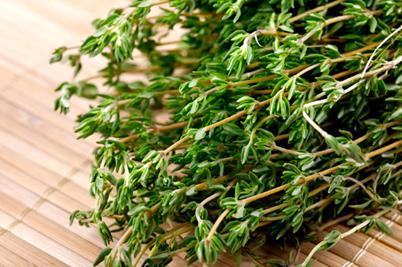Thyme اویشن
DESCRIPTION
Thyme, Thymus vulgaris, is a small, perennial, evergreen shrub in the family Lamiaceae grown for its leaves which are used as a herb. The thyme plant has an erect or ascending growth habit and possesses many woody, branching stems. The leaves of the thyme plant are linear and are arranged alternately on the stems. The leaves are densely covered in minute hairs and have numerous red-brown oil glands on the surface which take the appearance of small dots. The leaves can be green or variegated. The plant produces whorls of tiny pink, lilac or pale purple flowers on a terminal spike and tiny brown fruits, each with one seed. Thyme can reach a height of up to 50 cm (20 in) and can be grown as an annual or a perennial. Thyme may also be referred to as common Thyme and originates from the Mediterranean.
HISTORY
For thousands of years, thyme has been a star of the herb garden. As an antidote for poison, a plague preventative, a symbol of bravery in battle and a stalwart companion to the grave, thyme has a more storied past than you’d think if you were walking past it in the supermarket today.
Thyme’s reputation as a healer and protector goes back thousands of years. In the Roman era, it was widely held that eating thyme either before a meal would protect you from poison. For obvious reasons, this made the herb a particular favorite of the emperors. It was even said that a bath in warm water liberally dosed with thyme could stop the effects of poison.
Thyme was also associated with courage, bravery and strength in ancient times. Roman soldiers exchanged sprigs of thyme as a sign of respect. Greeks and Romans burned bundles of thyme to purify their temples and homes.
All along, of course, thyme remained one of Europe’s most favorite cooking herbs (along with the ever-popular rosemary and sage). Monasteries, which served for hundreds of years as the keepers of medicinal knowledge as well as the art of keeping a good kitchen garden, made frequent use of thyme in their breads, soups and roasts.
USES
Thyme leaves and flowers can be used fresh or dried as a flavored herb in cooking. Bees which collect nectar from thyme flowers produce a high quality honey. Essential oil can be extracted from the leaves and is commonly used in the manufacture of perfume or as a flavoring in toothpastes.
MEDICINAL USES
Nowadays, it is prescribed by herbalists for intestinal worms, gastrointestinal ailments, bronchial problems, laryngitis, diarrhea, and also lack of appetite. It has antiseptic properties, and can be used as a mouthwash, skin cleanser, anti-fungal agent for athlete’s foot and as an anti-parasitic for lice, scabies, and crabs. For skin inflammations and sores, make a poultice by mashing the leaves into a paste.
To use Thyme as an anti-fungal agent or as a parasitic, mix four ounces of Thyme to a pint of alcohol, or buy the essential oil and use sparingly on the affected area. For bronchitis and gastric problems, make a tea to be used once per day. Add honey as a sweetener, if desired.
The essential oil of Thyme (Thymol) can cause adverse reactions if taken in it’s pure form, so use Thyme-based medications sparingly. If taken in a tea, drink only once per day, and if used on the skin, be aware that it may cause irritation.

